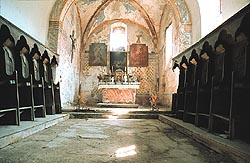Le Certose di Monte Benedetto e Banda

I monaci certosini giunsero in Valle di Susa alla Losa, nei pressi di Gravere, tra il 1189 e il 1191. Pochi anni dopo, nel 1197, chiesero al conte Tommaso I di Savoia di potersi trasferire a Monte Benedetto, sopra Villar Focchiardo, in quanto la prima sistemazione non soddisfaceva il loro desiderio di isolamento. La loro Regola infatti esaltava l'estraneità dal mondo della vita monacale, inducendo i certosini a collocare i propri monasteri in luoghi isolati.
L'espansione fondiaria della certosa, promossa inizialmente dal conte Tommaso, continuò grazie alle numerose donazioni da parte di nobili valsusini e ad un'oculata politica di acquisti.
I monaci certosini, che conducevano vita eremitica ciascuno nella propria cella, non svolgevano attività manuale; la gestione dei beni era affidata a conversi e salariati sotto la guida di un priore.
I resti della certosa, limitati al nucleo principale e alla chiesa abbaziale, sono oggi di proprietà privata. La chiesa, un tempo ridotta a fienile, è stata recentemente fatta oggetto di un intervento di restauro da parte del Parco Orsiera-Rocciavrè, all'interno del cui territorio si trova oggi il complesso monastico. L'edificio è a una sola navata, ed è stato ampliato in fasi successive come rilevabile dalle tracce sulle pareti esterne. Nel complesso la chiesa è in stile romanico anche se non mancano alcuni particolari gotici. Il campanile è dell'inizio del XIII secolo. La certosa è oggi ridotta a rustico mentre delle celle non resta più traccia.
Le linee architettoniche essenziali, concretizzano gli ideali di povertà e distacco dal mondo dello spirito certosino. Sopra quello che fu l'ingresso principale, oggi murato, è visibile un affresco quattrocentesco rappresentante la Vergine col Bambino venerata da alcuni monaci. Poco più a valle della certosa sono situati i ruderi della correria, i locali che erano riservati ai conversi e ai salariati.

Verso la metà del XV secolo, forse a causa delle frequenti inondazioni del vicino torrente, Monte Benedetto venne abbandonata dai monaci che si trasferirono nella sottostante località di Banda. Nel 1642 il monastero fu infine soppresso e incorporato nel patrimonio della Certosa di Collegno.
La Certosa di Banda è oggi inglobata in un cascinale e sono visibili solo la chiesa, i resti del chiostro e di alcune celle. La chiesa, in stile romanico e costruita tra il 1200 e il 1250, era ricca di arredi trasferiti successivamente in altre sedi, come il trittico della Madonna con Bambino e i santi Ugo di Lincoln e di Grenoble, della fine del XV secolo, ora nella cattedrale di San Giusto a Susa. Vi si conservano ancora gli stalli del coro, notevole opera di un intagliatore franco-piemontese della seconda metà del XV secolo.
|
The Mount Benedict and Banda Carthusian Monasteries

The Carthusian monks reached the Susa Valley (Turin province, Italy) between the 1189 and the 1191 at the Losa, near Gravere. Few years after, in the 1197, they asked to Tommaso of Savoy to move to Mount Benedict, in the mountains over Villar Focchiardo, to be more isolated. The Rule exalted the extraneity from the world of their monk life, inducing the Carthusians to build their monasteries in isolated places.
The territorial expansion of the charterhouse, promoted initially from Tommaso Count, continued thanks to the numerous donations. The Carthusian monks conducted an hermitic life each one in their own cell and did not carry out manual activity.
The remains of the charterhouse, limited to the main nucleus and the abbey church, are today of private property.
The church, reduced to barn, has been recently restored by the Orsiera-Rocciavré Park, in which territory it is actually included. The building has a single nave, and has been widened in successive phases, as can be seen from the traces on the external walls. Stylistically the church is Romanesque even if some gothic particulars can be found. The bell tower is of the beginning of the XIII century. No more remain of the cells does exist. The essential architectonic lines, realise the ideals of poverty and separation from the world of the Carthusian spirit. Above the old main entering, today walled, a fourteenth century fresco is visible. It represents the Holy Mary with the Child Jesus venerated by some monks. The ruins of the "correria" are situated a little lower toward the valley: they hosted the wage-earners.

Towards the half of the XV century, perhaps because of the frequent flooding of the close torrent, Mount Benedict was abandoned and the monks moved to the below locality of Banda. In 1642 the monastery was definitively closed and incorporated in the patrimony of the Collegno Carthusian Monastery.
The Banda Carthusian Monastery is today transformed in a farmstead. Only the church, the rests of the cloister and some cells are still visible. The church, in style Romanesque and constructed between 1200 and 1250, was rich of furnishings, subsequently transferred in other monasteries, as the triptych of the Holy Mary with Child Jesus and the saints Ugo di Lincoln and of Grenoble, of the end of the XV century, now in the Saint Giusto cathedral of Susa. The seats of the chorus, a remarkable work of a French-Piedmontese engraver of the second half of the XV century, are still preserved there.

|